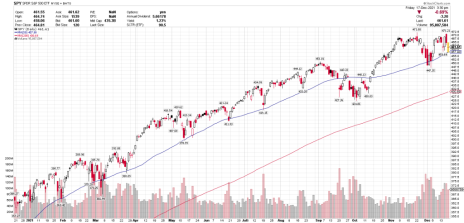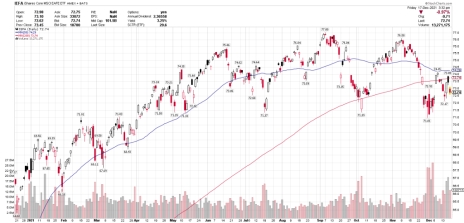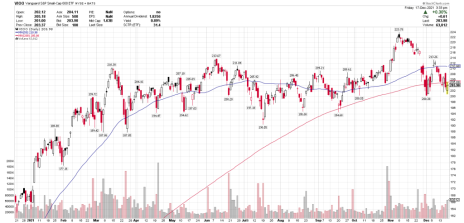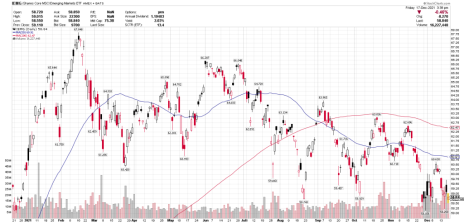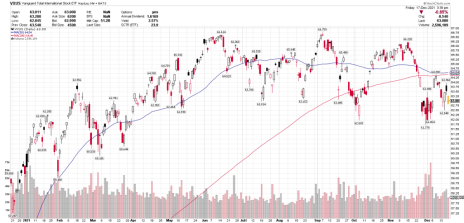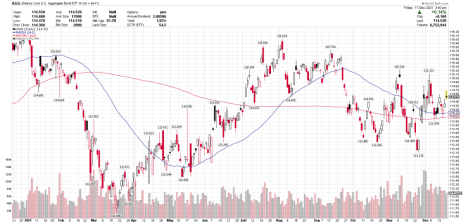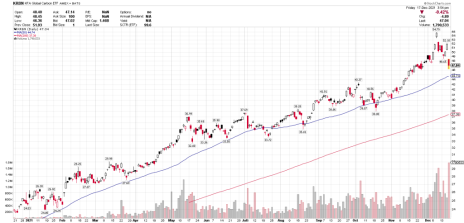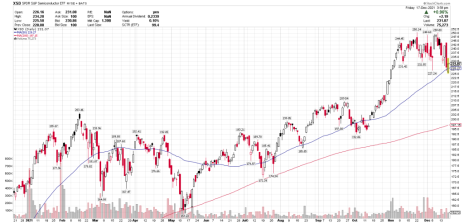Does your ETF portfolio look the same this year as it did in 2021, or even for the past five or 10 years?
With this first issue of the Cabot ETF Strategist, you’ll get the essential portfolio allocations to get the year started right. Whether you’re an aggressive, moderate or conservative investor, theres’s a portfolio for you.
Both equities and fixed-income asset classes are getting a slow start to the year. That’s good news for anyone rebalancing or reinvesting their portfolio, as you can buy ETFs at potentially lower valuations.
Introduction
Welcome to the first issue of the Cabot ETF Strategist.
In this new publication, you’ll get actionable ideas for allocating your long-term portfolio using exchange-traded funds.
Our goal is to help you grow your portfolio value while simultaneously mitigating risks that could damage your returns. The key to achieving that balance is a globally diversified portfolio.
Diversification typically reduces your overall levels of portfolio volatility and risk. When investments in one area underperform, others will pick up the slack. At the very least, some will be less of a drag, which does help to stem losses.
While it may seem most desirable to have all your investments moving higher at similar rates, that’s actually a way to add risk. Ideally, a portfolio with negatively correlated assets – those that move in different directions at the same time – will smooth your return.
Here’s an example: In the decade between January 1, 2000, and December 31, 2009, U.S. large-cap stocks, as tracked by the S&P 500, underperformed several other domestic and international stock and bond asset classes. Even a conservative mix of stocks, fixed income, and cash outpaced the S&P 500 over the course of the decade.
So how could you avoid suffering through a decade of negative returns in the S&P 500? The answer is very simple: Asset allocation would have done the trick.
This newsletter is for anyone who wants to invest in ETFs and the occasional mutual fund, but it’s especially for those who may be new to asset allocation to achieve goals such as retirement.
In our monthly issues, we’ll give you all the information you need to make informed decisions on which funds and ETFs are best for you, given your goals, time horizon and risk tolerance.
Other subscriber benefits include:
- Plan of action when it’s time to rebalance.
- Special alerts if there’s an important market development that may require you to take action between issues.
- ETFs for tactical allocation to potentially add alpha to your portfolio.
- Subscriber-only podcast focusing on ETFs and market conditions that may affect your investment returns.
Portfolios & Updates
Risk-Adjusted Portfolios
In this first issue, I have already begun building ETF portfolios appropriate for those with either an aggressive or moderate risk tolerance.
These portfolios are intended to be the “baseline.” That means we will be adjusting these in subsequent issues, to fine-tune your exposure to leading asset classes as market conditions change.
As of this publication, these allocated funds can be considered a “buy.” We’ll shift the individual holdings to “hold” or “sell” status as market conditions necessitate.
I’m excited to get you started on constructing a portfolio that should offer you tremendous opportunities to meet your financial goals through growth while mitigating your risk.
Happy Investing!
Aggressive Growth Portfolio
This portfolio is designed for investors seeking portfolio growth through an all-equity ETF portfolio. Aggressive growth seeks to return the highest capital gains.
An all-equity portfolio will be more aggressive than a portfolio that also holds bonds or significant cash.
Investors will own both U.S. and international stocks, including those issued by companies in developed and emerging markets.
| Aggressive Portfolio | ||||||
| ETF | Symbol | Buy Date | Buy Price | Price on 1/10/22 | Gain/Loss | Rating |
| iShares Core MSCI EAFE | IEFA | New | — | 74 | — | Buy |
| iShares Core MSCI Emerging Markets | IEMG | New | — | 60 | — | Buy |
| SPDR S&P 500 ETF | SPY | New | — | 469 | — | Buy |
| Vanguard S&P Small-Cap 600 ETF | VIOO | New | — | 207 | — | Buy |
The S&P 500 is something like a pantry staple, like coffee (if you’re in my house). Because large-cap U.S. stocks constitute such a large portion of worldwide market capitalization, it’s not an asset class you can ignore.
SPDR S&P 500 ETF (SPY)
Large-cap U.S stocks are a backbone of any portfolio. That’s true even for non-U.S. investors. The S&P 500 comprises about 70% to 80% of the total U.S. stock market, and by extension, about 35% to 40% of global market cap.
The SPDR S&P 500 ETF has an expense ratio of 0.095%, making it an efficient way to access this asset class.
iShares Core MSCI EAFE (IEFA)
The iShares Core MSCI EAFE ETF tracks most of the investable non-U.S. market via the MSCI EAFE Investable Market Index. This index comprises stocks of all market caps hailing from developed markets in Europe, Australia, Asia, and the Far East.
The fund’s benchmark focuses on companies in the top 99% of each country’s market capitalization and weights holdings by market cap. The index reconstitutes twice a year, in May and November. In February and August it does minor rebalancing and makes small additions, such as new IPOs that qualify by market cap.
Its risk profile is slightly lower than the S&P 500 at the moment, with a beta of 0.81.
Vanguard S&P Small-Cap 600 ETF (VIOO)
The Vanguard S&P Small-Cap 600 Index offers a broadly diversified basket of domestic small-cap stocks. As academic research going back to the 1960s finds, small caps, over time, tend to outperform larger stocks. That has not been the case in the past decade, although in the previous decade small caps did outperform. The message is: Maintain both large and small stocks in your portfolio, as leadership can and does rotate at times.
Because index provider Standard & Poor’s maintains a profitability requirement for this and other indexes, there’s what Morningstar calls “a slight quality tilt” to the portfolio. In other words, there’s a small bias toward companies likely to hold up better than others during a market downturn.
iShares Core MSCI Emerging Markets (IEMG)
This ETF tracks the MSCI Emerging Markets Investable Market Index, comprising stocks from 24 emerging markets, representing all market capitalizations. It holds 2,577 stocks, with the top 10 positions accounting for 21.35% of total assets.
The IEMG ETF has a beta of 0.83, somewhat lower than the S&P 500 at the moment. However, emerging-market stocks are riskier than those from developed markets for a number of reasons, including government and regulatory risk and lower liquidity, among others.
For exposure to emerging markets, I like this fund right now, partly because of the expense ratio, which is lower than other emerging-market funds. That means more money goes into your pocket, rather than a fund manager’s.
Moderate Growth Portfolio
The goal of the Moderate Growth Portfolio is to provide long-term growth balanced with income. Investors will own both U.S. and international stocks, including those issued by companies in developed and emerging markets. You also have exposure to government and corporate bonds, to provide potential income through interest payments.
| Moderate Growth Portfolio | ||||||
| ETF | Symbol | Buy Date | Buy Price | Price on 1/10/2022 | Gain/Loss | Rating |
| iShares Core US Aggregate Bond | AGG | New | — | 112 | — | Buy |
| iShares US Real Estate | IYR | New | — | 110 | — | Buy |
| Vanguard Total Stock Market ETF | VTI | New | — | 236 | — | Buy |
| Vanguard Total International Stock ETF | VXUS | New | — | 63 | — | Buy |
Vanguard’s investment and screening process includes steps that favor investors. For example, its screens for fund additions are quite stringent. In addition, according to Morningstar, the index spreads rebalancing trades over five days to help mitigate transaction costs.Investors should be aware that market-cap-weighted funds can result in a concentration in the “usual suspects” – the largest U.S. growth stocks, which in this case are Microsoft (MSFT), Apple (AAPL), Amazon (AMZN), Alphabet (GOOGL) and Tesla (TSLA).
Vanguard Total Stock Market ETF (VTI)
The Vanguard Total Stock Market Index Fund tracks the broadly diversified U.S. equity market. That means including all market capitalizations in its portfolio, although there is a tilt toward mega caps and large caps.
Vanguard Total International Stock ETF (VXUS)
The Vanguard Total International Stock Index Fund is a broad portfolio tracking the FTSE Global All Cap ex-U.S. Index. This index includes all market capitalizations from non-U.S. developed and emerging markets. It’s important to include these assets in your portfolio to capture gains, especially if overseas stocks outperform domestic stocks in any market cycle.
The wide diversification helps to mitigate risk. This ETF tracks 7,717 stocks, with the 10 largest holdings comprising just 9.3% of total fund assets. That relatively low exposure can help smooth risk.
iShares Core U.S. Aggregate Bond (AGG)
The iShares Core U.S. Aggregate Bond ETF tracks the Bloomberg Barclays U.S. Aggregate Bond Index, comprising investment-grade dollar-denominated bonds with at least one year to maturity.
The portfolio has a tilt toward more liquid and larger bonds, which can mitigate risk, which is exactly what you want in a bond fund. Use fixed income primarily to dampen the risk of equities in your portfolio.
This ETF includes 70.04% AAA-rated bonds, which mitigates risk within the fund itself. This means credit risk is limited, although it exposes the fund to greater interest-rate risk. However, a low expense ratio of just 0.040% offsets that risk.
iShares US Real Estate (IYR)
Diversification with some alternative asset classes is a good way to smooth volatility through various market cycles. Real estate provides that diversification and can be easily accessed through an ETF like this one.
The fund offers a yield of 1.73%, which is due to overweights in equities with higher dividends or buybacks.
This ETF tracks the Dow Jones U.S. Real Estate Capped Index, which measures the performance of the real estate sector of the U.S. equity market. Its portfolio is top-heavy relative to some other funds; the top 10 holdings account for 41.63% of total assets. However, low portfolio turnover is a mitigating factor, which tends to keep the expense ratio low.
ETFs of Interest
Other ETFs outside of your allocation can add alpha to your portfolio. In some cases, particularly in market cycles where equities are underperforming fixed income, they can also smooth volatility.
Global X Cybersecurity ETF (BUG) - WATCH
Analysts believe the global cybersecurity market could grow from nearly $180 billion this year to more than $370 billion by 2028. If you follow tech news even in the most cursory sense, you realize that cybersecurity is a growing problem, with plenty of opportunity for companies with specific solutions.
The Global X Cybersecurity ETF (BUG) seeks to provide investment results that correspond generally to the price and yield performance of the Indxx Cybersecurity Index.
This ETF is currently in a correction but getting solid support at its 10-week moving average, an indication that investors are holding shares and buying more at a lower valuation.
For now, this is a watchlist ETF until we can identify a confirmed uptrend.
KraneShares Global Carbon Strategy ETF (KRBN) - WATCH
Another important investable theme is environmental sustainability.
The KraneShares Global Carbon Strategy ETF (KRBN) is benchmarked to IHS Markit’s Global Carbon Index, which offers broad coverage of cap-and-trade carbon allowances.
That index tracks the most-traded carbon credit futures contracts, which means it has built-in hedging, along with a way to express the theme of responsible investing.
According to IHS Markit, as of December 31, 2020, the global price of carbon was $24.05 per ton of CO2. It is estimated that carbon allowance prices need to reach $147 per ton of CO2 to meet a 1.5°C global warming limit, according to fund literature.
This ETF may be taking a much-needed breather after rallying 110.84% year to date. With a decline of nearly 9% the week ended December 17, the ETF is one to keep an eye on as it regroups for its next uptrend.
SPDR S&P Semiconductor ETF (XSD) - WATCH
The ongoing global chip shortage means chipmakers will benefit from a mismatch in the supply and demand equation.
The SPDR S&P Semiconductor ETF provides exposure to the semiconductors segment of the S&P Total Market Index. It includes large, mid and small-cap stocks. The ETF is designed to allow investors to take either a strategic or tactical position at a more targeted level than sector-based investing, which includes a broader range of sub-industries.
This ETF is currently trending slightly lower and successfully testing its 10-week moving average. A pullback is not unusual even in a fast-growth industry, especially as the broader market is exhibiting some choppiness.
This ETF is classified as one to watch until we see a definitive bounce higher.
The next Cabot ETF Strategist issue will be published on February 8, 2022.
